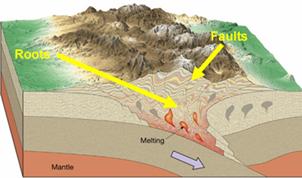Regional
Regional metamorphism affects large volumes (regions) of rock, especially in the mountain chains that form when continents collide.
Regionally metamorphosed rocks usually have a squashed, or foliated appearance – examples include slate, schist and gneiss (pronounced “nice”), formed by metamorphism of mudstones, and also marble which is formed by metamorphism of limestone.
Regionally metamorphosed rocks usually have a squashed, or foliated appearance – examples include slate, schist and gneiss (pronounced “nice”), formed by metamorphism of mudstones, and also marble which is formed by metamorphism of limestone.

View an animation showing metamorphism.
The diagram below shows how mountains are built when continents collide.
The diagram below shows how mountains are built when continents collide.

They get very hot (500oC or more) and so re-crystallise to form new minerals and textures.
Rocks metamorphosed at depth may later be pushed up along faults, bringing them closer to the surface.
As the mountains are eroded away by glaciers and rivers, these rocks become exposed for us to see.

